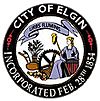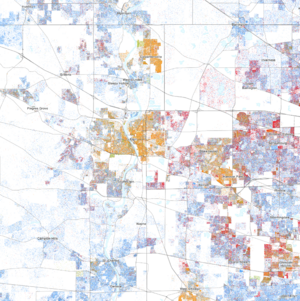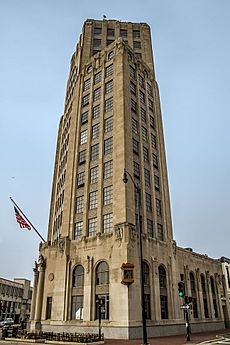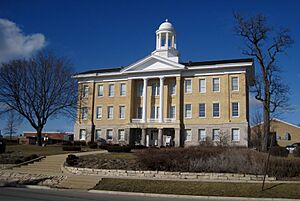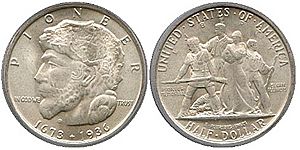Elgin, Illinois facts for kids
Quick facts for kids
Elgin, Illinois
|
|||
|---|---|---|---|
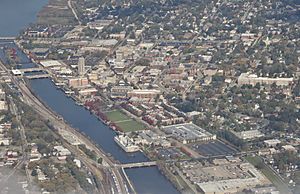
Aerial view of downtown Elgin
|
|||
|
|||
| Nickname(s):
The City in the Suburbs
|
|||
| Motto(s):
The Jewel of the Midwest
|
|||
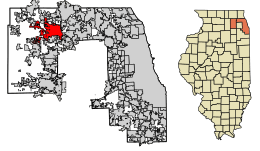
|
|||
| Country | United States | ||
| State | Illinois | ||
| Counties | |||
| Townships |
|
||
| Founded | 1835 | ||
| Incorporated (city) | April 24, 1854 | ||
| Government | |||
| • Type | Council–manager | ||
| Area | |||
| • Total | 38.60 sq mi (99.97 km2) | ||
| • Land | 38.03 sq mi (98.49 km2) | ||
| • Water | 0.57 sq mi (1.49 km2) 1.43% | ||
| Elevation | 810 ft (250 m) | ||
| Population
(2020)
|
|||
| • Total | 114,797 | ||
| • Density | 3,018.83/sq mi (1,165.59/km2) | ||
| Standard of living (2011) | |||
| • Median household income | $56,091 | ||
| • Median home value | $209,800 | ||
| Time zone | UTC−6 (Central) | ||
| • Summer (DST) | UTC−5 (Central) | ||
| ZIP code(s) |
60120–60125
|
||
| Area code(s) | 331, 847 and 224 | ||
| Geocode | 17-23074 | ||
| FIPS code | 17-23074 | ||
| Demonym | Elginite, Elginer | ||
Elgin (/ˈɛldʒɪn/ EL-jin) is a city in Cook and Kane counties in the U.S. state of Illinois. It is located about 35 mi (56 km) northwest of Chicago along the Fox River. In the 2020 census, the city had a population of 114,797 people. This makes Elgin the sixth-most populous city in Illinois.
Contents
History of Elgin
Long ago, Native American tribes lived in the Elgin area. They had settlements and burial mounds here. In the 1830s, these tribes moved from the area. This opened the way for new settlers. Soldiers marching through the Fox River valley during a war in 1832 shared stories of the rich land. They spoke of fertile soils and flowing springs.
In April 1835, two brothers, James T. Gifford and Hezekiah Gifford, traveled west from New York. They were looking for a good spot on the stagecoach route from Chicago to Galena, Illinois. They found a place where the Fox River could be crossed with a bridge. They decided to establish a city there. They named it "Elgin" after a Scottish song.
Elgin's Early Industries
Elgin first became known for its butter and dairy products. These goods were sold to the city of Chicago. In 1866, Gail Borden opened a condensed milk factory in Elgin. The local library was later named in his honor.
The dairy industry became less important when the Elgin Watch Company arrived. This watch factory was very important to Elgin. It employed people for three generations, from the late 1800s to the mid-1900s. It was the largest producer of fine watches in the United States. The factory stopped making watches in 1965. Today, the clocks at Chicago's Union Station still have the Elgin name.
Elgin National Road Races
From 1910 to 1920, Elgin hosted the Elgin National Road Races. These races brought in top national racing champions. Many major car makers also came to compete. The Elgin Watch Company sponsored the races. They offered a $1,000 prize and a silver trophy. These races helped a lot in developing modern cars.
Elgin's Inventions and Education
Elgin has a strong history of education and new ideas. The Elgin Academy is in Elgin. It is the oldest coeducational (for both boys and girls), non-religious college preparatory school west of the Allegheny Mountains. Elgin High School has many famous former students. These include Navy admirals, a Nobel Prize winner, and Olympic athletes.
An Elgin resident named John Murphy invented the motorized streetsweeper in 1914. He later started the Elgin Sweeper Corporation. Pioneering African-American chemist Lloyd Hall was from Elgin. So was the famous marketer Earl "Madman" Muntz. Max Adler, who founded the Adler Planetarium in Chicago, was also from Elgin.
Modern Elgin Developments
In the 1990s, Elgin became one of the few cities in northern Illinois to have a riverboat casino. The Grand Victoria Casino brought a lot of money to the city. It attracted millions of visitors each year. The Grand Victoria Foundation gives money from the casino to local non-profit groups.
Elgin has seen many new developments in recent years. In 2013, it was a top city in the Chicago metropolitan area for new home construction. Downtown Elgin has also been updated. New homes, apartments, and art galleries have opened. The Gail Borden Public Library moved into a large new building in 2003. It opened a satellite branch in 2009. The city also opened the Centre of Elgin, a big recreation facility.
Elgin is home to a large Laotian American community. Elgin has been a sister city with Vientiane, the capital of Laos, since 1967. Many Laotian Americans have opened stores and restaurants. Elgin also has a large Latino population. In 2020, 45.7% of the population was Latino.
Geography of Elgin
Elgin's Location and Land Area
Elgin is located at 42°2′18″N 88°19′22″W / 42.03833°N 88.32278°W. The city covers a total area of about 38.60 square miles (99.97 km2). Most of this area, about 38.03 square miles (98.50 km2), is land. The remaining 0.57 square miles (1.48 km2) is water.
Elgin's Climate and Weather
| Climate data for Elgin, Illinois (1991–2020 normals, extremes 1983–present) | |||||||||||||
|---|---|---|---|---|---|---|---|---|---|---|---|---|---|
| Month | Jan | Feb | Mar | Apr | May | Jun | Jul | Aug | Sep | Oct | Nov | Dec | Year |
| Record high °F (°C) | 63 (17) |
70 (21) |
83 (28) |
91 (33) |
97 (36) |
101 (38) |
102 (39) |
98 (37) |
95 (35) |
89 (32) |
76 (24) |
68 (20) |
102 (39) |
| Mean daily maximum °F (°C) | 30.1 (−1.1) |
34.2 (1.2) |
46.1 (7.8) |
58.7 (14.8) |
70.3 (21.3) |
80.1 (26.7) |
84.1 (28.9) |
82.3 (27.9) |
75.7 (24.3) |
62.7 (17.1) |
47.6 (8.7) |
35.5 (1.9) |
59.0 (15.0) |
| Daily mean °F (°C) | 22.1 (−5.5) |
25.5 (−3.6) |
36.2 (2.3) |
47.9 (8.8) |
59.3 (15.2) |
69.2 (20.7) |
73.7 (23.2) |
71.8 (22.1) |
64.3 (17.9) |
51.8 (11.0) |
38.8 (3.8) |
27.8 (−2.3) |
49.0 (9.4) |
| Mean daily minimum °F (°C) | 14.1 (−9.9) |
16.8 (−8.4) |
26.3 (−3.2) |
37.0 (2.8) |
48.3 (9.1) |
58.4 (14.7) |
63.2 (17.3) |
61.2 (16.2) |
52.8 (11.6) |
40.9 (4.9) |
30.1 (−1.1) |
20.1 (−6.6) |
39.1 (3.9) |
| Record low °F (°C) | −27 (−33) |
−25 (−32) |
−9 (−23) |
11 (−12) |
28 (−2) |
36 (2) |
45 (7) |
40 (4) |
29 (−2) |
18 (−8) |
4 (−16) |
−24 (−31) |
−27 (−33) |
| Average precipitation inches (mm) | 2.02 (51) |
1.87 (47) |
2.37 (60) |
3.96 (101) |
5.12 (130) |
4.46 (113) |
3.98 (101) |
4.33 (110) |
3.53 (90) |
3.31 (84) |
2.68 (68) |
2.22 (56) |
39.85 (1,012) |
| Average snowfall inches (cm) | 9.5 (24) |
8.0 (20) |
3.7 (9.4) |
0.8 (2.0) |
0.0 (0.0) |
0.0 (0.0) |
0.0 (0.0) |
0.0 (0.0) |
0.0 (0.0) |
0.0 (0.0) |
1.4 (3.6) |
8.7 (22) |
32.1 (82) |
| Average precipitation days (≥ 0.01 in) | 10.0 | 7.9 | 9.6 | 12.5 | 13.1 | 11.1 | 9.4 | 10.1 | 9.1 | 10.8 | 9.9 | 10.4 | 123.9 |
| Average snowy days (≥ 0.1 in) | 7.1 | 5.1 | 2.7 | 0.7 | 0.0 | 0.0 | 0.0 | 0.0 | 0.0 | 0.0 | 1.1 | 5.2 | 21.9 |
| Source: NOAA | |||||||||||||
Elgin has experienced severe weather events. On March 28, 1920, several tornadoes hit the Fox River area. They caused a lot of damage in Chicago and nearby towns. Many buildings were destroyed. More recently, on July 12, 2023, multiple tornadoes went through Elgin. The strongest one was an EF-1 tornado. It had winds up to 100 miles per hour.
Elgin's Population and People
| Historical population | |||
|---|---|---|---|
| Census | Pop. | %± | |
| 1860 | 2,797 | — | |
| 1870 | 5,441 | 94.5% | |
| 1880 | 8,787 | 61.5% | |
| 1890 | 17,823 | 102.8% | |
| 1900 | 22,433 | 25.9% | |
| 1910 | 25,976 | 15.8% | |
| 1920 | 27,454 | 5.7% | |
| 1930 | 35,929 | 30.9% | |
| 1940 | 38,333 | 6.7% | |
| 1950 | 44,223 | 15.4% | |
| 1960 | 49,447 | 11.8% | |
| 1970 | 55,691 | 12.6% | |
| 1980 | 63,798 | 14.6% | |
| 1990 | 77,010 | 20.7% | |
| 2000 | 94,487 | 22.7% | |
| 2010 | 108,188 | 14.5% | |
| 2020 | 114,797 | 6.1% | |
| 2022 (est.) | 113,177 | 4.6% | |
| U.S. Decennial Census 2010 2020 |
|||
In 2020, Elgin had 114,797 residents. There were 36,825 households in the city. About 37.5% of these households had children under 18 living there. The average household size was 3.60 people.
The city's population is diverse. About 43.42% of residents were White. About 6.60% were African American. About 6.48% were Asian. People of Hispanic or Latino background made up 47.44% of the population.
The median age in Elgin was 34.9 years. This means half the people were younger and half were older.
| Race / Ethnicity (NH = Non-Hispanic) | Pop 2000 | Pop 2010 | Pop 2020 | % 2000 | % 2010 | % 2020 |
|---|---|---|---|---|---|---|
| White alone (NH) | 50,831 | 46,089 | 42,261 | 53.80% | 42.60% | 36.81% |
| Black or African American alone (NH) | 6,100 | 7,467 | 7,207 | 6.46% | 6.90% | 6.28% |
| Native American or Alaska Native alone (NH) | 135 | 144 | 150 | 0.14% | 0.13% | 0.13% |
| Asian alone (NH) | 3,600 | 5,675 | 7,285 | 3.81% | 5.25% | 6.35% |
| Pacific Islander alone (NH) | 14 | 19 | 27 | 0.01% | 0.02% | 0.02% |
| Other race alone (NH) | 72 | 115 | 392 | 0.08% | 0.11% | 0.34% |
| Mixed race or Multiracial (NH) | 1,305 | 1,558 | 3,015 | 1.38% | 1.44% | 2.63% |
| Hispanic or Latino (any race) | 32,430 | 47,121 | 54,460 | 34.32% | 43.55% | 47.44% |
| Total | 94,487 | 108,188 | 114,797 | 100.00% | 100.00% | 100.00% |
Elgin's Economy
Elgin has many important employers. These companies and organizations provide jobs for many people in the city.
| # | Employer | # of Employees |
|---|---|---|
| 1 | Elgin Area School District U46 | 4,329 |
| 2 | J.P. Morgan Chase | 2,500 |
| 3 | Advocate Sherman Hospital | 2,094 |
| 4 | John B. Sanfilippo (Fisher Nuts) | 1,742 |
| 5 | Provena Saint Joseph Hospital | 1,349 |
| 6 | Elgin Community College | 1,064 |
| 7 | Grand Victoria Casino | 800 |
| 8 | Elgin Mental Health Center | 750 |
| 9 | American NTN Bearing | 675 |
| 10 | City of Elgin | 659 |
| 11 | Motorola Solutions | 400 |
| 12 | Communication Test Design Inc | 312 |
Arts and Culture in Elgin

Elgin is a center for arts and culture. It is home to the Elgin Symphony Orchestra. Other music groups include the Elgin Youth Symphony Orchestra and the Elgin Master Chorale. You can also hear outdoor music at the Wing Park Bandshell.
There are several theater groups in Elgin. These include the Janus Theatre Company and the Elgin Theatre Company. The The Hemmens Cultural Center and Elgin Community College's Visual & Performing Arts Center host many shows. These range from dance performances to comedy acts.
After some tough times in the 1980s, downtown Elgin has become lively again. This happened with the opening of the Grand Victoria riverboat casino. Many old buildings have been turned into cool clubs and restaurants.
Elgin's Architecture and Historic Homes
Elgin is known for its beautiful old buildings. Many homes are from the Victorian era. Some are great examples of the Queen Anne style. These grand homes once belonged to leaders of the National Watch Company. Many interesting Sears Catalog Homes were also built in Elgin. These homes came as kits between 1908 and 1940.
The Elgin Tower Building and the Elgin Professional Building are two tall buildings. They were built when Elgin was growing fast. The Tower Building has recently been updated into apartments.
Even older than Victorian homes are those made of native cobblestone. Elgin used to have one of the largest collections of cobblestone homes. Several of these homes, built by the first settlers, are still standing. You can see them in Elgin's historic districts. Two of these districts are recognized by the National Register of Historic Places.
The Elgin Public Museum at Lords Park is a special building. It was the oldest building in Illinois built specifically as a museum. It is still used for that purpose today.
"Open Elgin" is a free tour of downtown Elgin's architecture. Each April, many buildings open their doors for visitors. This event allows people to explore Elgin's historic structures.
Parks and Recreation in Elgin
Elgin has many parks and fun places. Lords Park is a large park with 112-acre (45 ha) of space. It has the Elgin Public Museum and a small zoo with American bison. Wing Park is 121-acre (49 ha) and includes a golf course and a swimming pool. Other golf courses in Elgin are the Highlands of Elgin and the Elgin Country Club.
The Centre of Elgin is one of the largest city recreation centers in the United States. It has an aquatic park and a climbing wall. The Elgin Sports Complex has ten lighted ballfields and ten soccer fields. It also has The Hill BMX track. This complex hosts many sports tournaments.
Elgin is connected to other towns by the Fox River Trail bike path. You can bike north to Algonquin and Dundee. You can also bike south to St. Charles, Geneva, and Batavia.
Elgin's Natural Habitats
Elgin still has some of the natural areas that first attracted settlers. To the east, the city borders the 4,200-acre (1,700 ha) Poplar Creek Preserve. This preserve has bike, hiking, and horse trails. The Shoe Factory Road Prairie inside the preserve shows what the area looked like long ago.
Elgin also has two special nature preserves: Bluff Spring Fen and Trout Park. Bluff Spring Fen has many different plant types. It includes a fen, which is a marshland with alkaline springs. Rare orchids grow there. Trout Park also has unique plant communities. It has a special forest with oaks, ashes, and maples. It also has uncommon trees like arborvitae and witch-hazel.
Elgin's Green Initiatives
In recent years, Elgin has worked to be more environmentally sustainable. In 2017, the city started free curbside textile recycling. It was the first city in Illinois to do this. Elgin also encourages residents to compost and use rain barrels. The city has a plan to create more renewable energy sources. It also plans for community gardens.
Education in Elgin
Elgin is served by five public school districts and 18 private schools.
Public Schools in Elgin
- Elgin Area School District U46: This is the second-largest school district in Illinois. It covers about 90 square miles (230 km2) and serves most of Elgin. Almost 40,000 students attend schools in this district. Elgin's public high schools include Elgin High School, Larkin High School, and Elgin Math and Science Academy Charter School.
- Community Unit School District 301: Serves some western parts of Elgin.
- Community Unit School District 300: Serves some northwestern parts of Elgin.
- Community Unit School District 303: Serves some southwestern parts of Elgin.
Private Schools in Elgin
Some of the private schools in Elgin include:
- Harvest Christian Academy
- The Einstein Academy
- Elgin Academy
- Good Shepherd Lutheran Preschool
- Northwest Baptist Academy
- St. Edward Central Catholic High School
- St. John's Lutheran School and Preschool
- St. Edwards Preparatory Catholic School
- St. Mary Elementary School
- St. Thomas More Catholic Elementary School
- Westminster Christian School
Colleges and Universities in Elgin
- Elgin Community College: This college serves many communities around Elgin. It is one of the fastest-growing community colleges in Illinois.
- Judson University: This is an accredited, four-year liberal arts college. It is located on the banks of the Fox River. Judson offers graduate programs in subjects like architecture and education.
- National Louis University: This is an accredited private university. It offers undergraduate and graduate programs in education, arts, sciences, and business.
Transportation in Elgin
Train Services in Elgin
Elgin has three stations for Metra trains. These stations are National Street, Elgin, and Big Timber Road. The Metra Milwaukee District West Line provides daily train service between Elgin and Chicago Union Station. Big Timber Road is the last stop on this line. However, on weekends and holidays, trains only go as far as the Elgin station.
In the past, Elgin had a streetcar system. It was also served by several interurban train lines. The Chicago Aurora and Elgin Railroad offered frequent service to Chicago.
Bus Services in Elgin
Local bus service in Elgin is provided by Pace. Pace operates about a dozen bus routes in the city. Most routes end at the Elgin Transportation Center downtown. Buses usually run every half hour. This makes it easy to transfer between routes. Some routes also travel from Elgin to other nearby towns. These include Carpentersville, Schaumburg, and St. Charles.
Pace also has an express bus route between Elgin and the Rosemont station. This station connects to Chicago's Blue Line train. The express bus travels along I-90.
Major Highways in Elgin
Important highways that pass through Elgin include:
Notable People from Elgin
Many famous people have come from Elgin. Here are a few:
- Brandon Johnson: The current Mayor of Chicago (since 2023).
- Max Adler: A vice-president of Sears & Roebuck. He helped fund the Adler Planetarium.
- Bruce Boxleitner: An actor.
- Paul Flory: A chemist who won the Nobel Prize in 1974.
- Jessica Mink: An astronomer who helped discover the rings around the planet Uranus.
- Earl "Madman" Muntz: A famous marketer and pioneer in car stereos.
- James Roche: A former chairman of General Motors.
- Tom Shales: A journalist who won the Pulitzer Prize in 1988.
- Jim Gaffigan: A well-known comedian and actor.
Elgin's Commemorative Coin
In 1936, a special commemorative silver half dollar coin was made for Elgin. It celebrated Elgin's 100th birthday. The coin was meant to help raise money for a statue. This statue was for pioneer families and was designed by sculptor Trygve Rovelstad. The coin sold for $1.50.
The front of the coin shows a pioneer's face. The back shows a pioneer family. The coin was not very popular at the time. This was likely because of the Great Depression and many other special coins being made. Five thousand coins were not sold and were melted down. The pioneer statue was finally put up in 2001.
Images for kids
See also
 In Spanish: Elgin (Illinois) para niños
In Spanish: Elgin (Illinois) para niños


